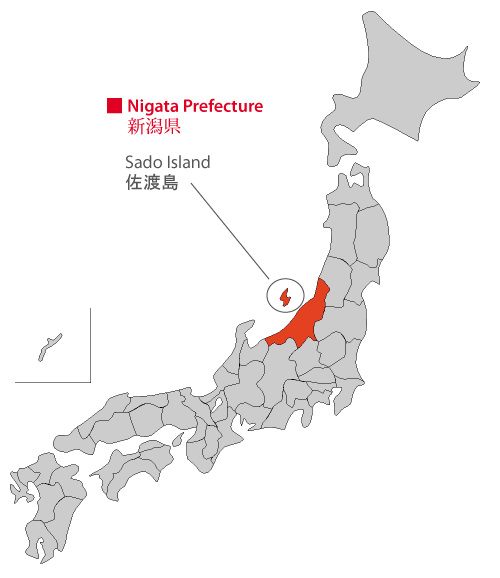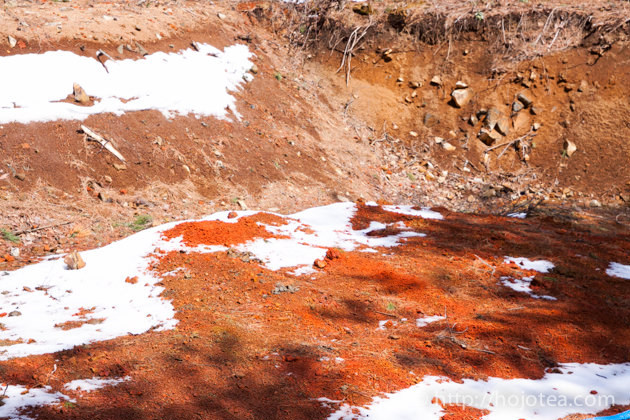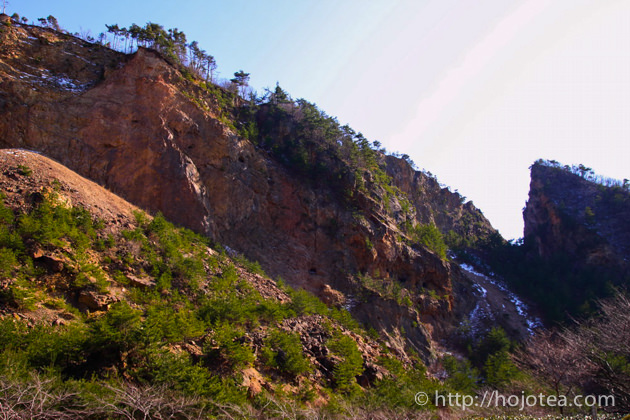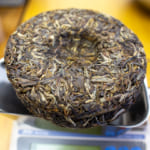- HOME >
- Teapot and Tea Equipment
Mumyoi Joaka clay teapot made by Watanabe Tozo
- [2014.10.12] Posted By Akira Hojo
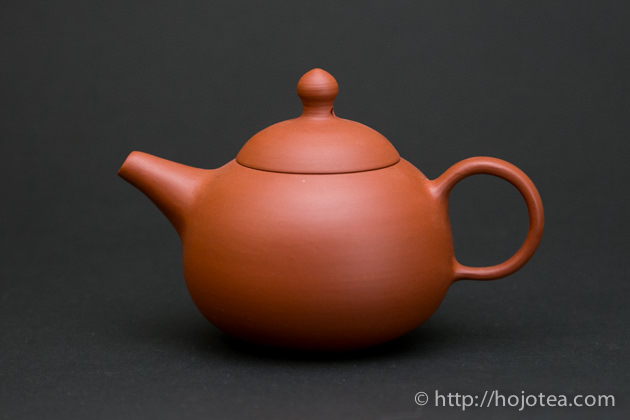
The red clay teapot traditionally produced in Sado Island is called Mumyoi Yaki. By tradition, the Mumyoi clay was collected from the tunnel inside the Aikawa gold mine. However, since the gold mine was shut down, the entryway to the mine cave was restricted and the artist in Sado was finding the clay from the alternative source, mostly in the mountain right next to the Aikawa gold mine. At Sado Island, the clay collected from the gold mine is called as Mumyoi Joaka to differentiate from the mumyoi clay collected from the mountain.
Mumyoi Joaka from the Gold Mine tunnel
The mumyoi clay collected inside the gold mine tunnel was called Joaka. The natural filtration of clay through the rocks and lands makes Joaka clay extremely finer particle size as compared to the standard mumyoi clay. In Edo era, Mumyoi Joaka clay was used as a medicine to stop bleeding before the teapot became a popular product in Aikawa town. According to the history, the medicine know as “Mumyoi” was very popular and expensive at that time.
The only definition of Joaka clay is that it is collected inside the gold mine and it consists of finer particles. In fact, the fineness of the particle size is a very important element. The finer clay can be fired at lower temperature and the clay becomes very porous. It gives greater influence to the taste of tea thanks to the large surface area.
We released Mumyoi Joaka clay
Despite the Mumyoi Joaka clay is really limited and rare, Watanabe Tozo has got Joaka clay. The clay was collected from one of the gold mine cave called Ogiri tunnel. We extended out a series of test to confirm the outcome of different firing temperature on the taste of tea and the appearance of taepot. After several months of study, we managed to finalize the ideal parameter for making teapots.
The mumyoi joaka clay enhances the body of tea. It establishes the flavour and the taste of tea richer. The base characteristic of this clay is similar to that of Shimizu Ken’s mumyoi clay teapot. It is suitable for fermented tea in particular.
No more source of Joaka clay due to the submission for the world heritage
Now Japanese government is attempting to apply Aikawa gold mine to the world heritage. Since two years ago, the assemblage of the clay around the Aikawa gold mine has been prohibited. The prohibited area also includes the mountain where our artists used to collect the clay. The artists on Sado Island have to survive only with the existing clay that they have stocked up so far. Needless to say, there will be no more opportunity to collect the Joaka clay in the future.
Related Articles
How to get the latest update on HOJO?
1. Follow Twitter, 2. Click "Like" on Facebook, and 3. Subscribe in newsletter. You can have the latest tea news from HOJO.
 Subscribe the Newsletter to enjoy the privileges
Subscribe the Newsletter to enjoy the privileges- You may receive a free sample upon purchase, or you may have the priority to purchase special products. So please remember to subscribe our newsletter as well as the social network.
- New Arrival of Akitsu Mumyoi and Nosaka Rough Clay Teapot
- A wide selection of teaware by Watanabe Tozo, a Sado-based artist of Mumyoi-yaki, has just arrived. This time, …
- Mang Fei Ripe Pu-erh Tea 2023 – Small-Batch Production from a Renowned Region
- Mang Fei Ripe Pu-erh Tea 2023 is now available. This is one of the highest-quality ripe pu-erh teas among our …
NEW ARTICLES
 Development of Firewood Roasted Hojicha Using Naturally Grown Tea from Yunnan
Development of Firewood Roasted Hojicha Using Naturally Grown Tea from Yunnan- We are currently staying in Yunnan Province for tea production. As the season nears its end, tea trees with pa …
 Exploring the Food Culture of Yunnan: Where Minority and Sichuan Cuisines Meet
Exploring the Food Culture of Yunnan: Where Minority and Sichuan Cuisines Meet- We are currently staying long-term in Yunnan Province for spring tea production. On rainy days or when there i …
 New Arrival of Akitsu Mumyoi and Nosaka Rough Clay Teapot
New Arrival of Akitsu Mumyoi and Nosaka Rough Clay Teapot- A wide selection of teaware by Watanabe Tozo, a Sado-based artist of Mumyoi-yaki, has just arrived. This time, …
 Managing Yunnan White Tea — Insights from the Field
Managing Yunnan White Tea — Insights from the Field- Since March 25, we have been in Yunnan Province, fully engaged in the production of white tea. In this column, …
 Mang Fei Ripe Pu-erh Tea 2023 – Small-Batch Production from a Renowned Region
Mang Fei Ripe Pu-erh Tea 2023 – Small-Batch Production from a Renowned Region- Mang Fei Ripe Pu-erh Tea 2023 is now available. This is one of the highest-quality ripe pu-erh teas among our …
 Yunnan Tea Trends 2025: Insights from the Fields
Yunnan Tea Trends 2025: Insights from the Fields- Since March 25, we have been in Yunnan Province. We will stay here until May to conduct tea production, packin …
 Why Do Some Teas Taste Astringent? Exploring the Causes and Mechanisms of Astringency
Why Do Some Teas Taste Astringent? Exploring the Causes and Mechanisms of Astringency- Tea can range from having no noticeable astringency to possessing a very strong one. What causes this astringe …
 The Impact of Heat Sources on Tea Flavor
The Impact of Heat Sources on Tea Flavor- It is widely recognized that the material of a kettle plays an important role in shaping the taste of water fo …
 New Release of Tang Li Shan Ripe Pu-erh Tea 2023
New Release of Tang Li Shan Ripe Pu-erh Tea 2023- We have released the 2023 edition of Tang Li Shan Ripe Pu-erh Tea. Tang Li Shan refers to a mountain located o …
 The New Release of Dong Shan Raw Pu-erh Tea 2023 and Jasmine Silver Needle
The New Release of Dong Shan Raw Pu-erh Tea 2023 and Jasmine Silver Needle- We have released Dong Shan Raw Pu-erh Tea 2023 and Jasmine Silver Needle. Dong Shan Raw Pu-erh Tea 2023 We hav …
Category
- New Arrival at HOJO Online Shop
- Featured Articles
- Newsletter
- Types of Tea
- Origin of Tea
- Teapot and Tea Equipment
- Tea Column
- How to enjoy tea
- Tea Processing
- How to choose quality tea
- Tea constituents and functional effect
- Safety of Tea
- Foods
- Tea Business Operation
- Hobby and Outdoor Activity
- Ranking of Tea
- Video
- FAQ
- Media Release
Profile

- AKIRA HOJO
- I invite you to experience my tea selections.I was born in Nagano, Japan. In university, I studied agricultural chemistry, and I have the master degree in food science. I worked in Japanese food industry for 10 years. I involved in R&D, QC and QA. As a factory manager, I implemented ISO9000 series and managed the factory.
- The Art of Tea Magazine
- We posted the article on “The Art of Tea Magazine No.9, the magazine is published in Taiwan. We featured …
- New Straits Times
- The Malaysian National Newspaper, New Straits Times featured HOJO Tea on 17-Oct-2007.
Shop Info

Address:Lot No. T-215, 3rd Floor, The Gardens Mall, Mid Valley City, Lingkaran Syed Putra, 59200 Kuala Lumpur
Tel: +603-2287-4537
Business Hour: 10am to 10pm

